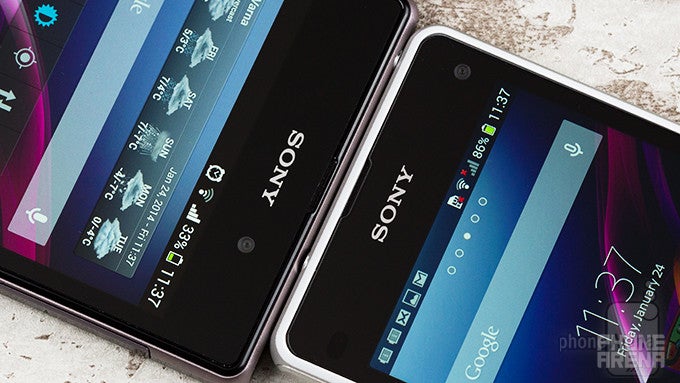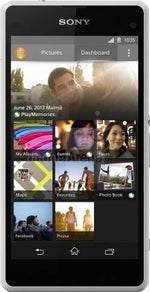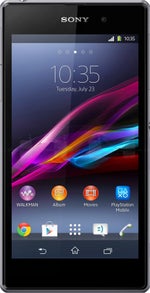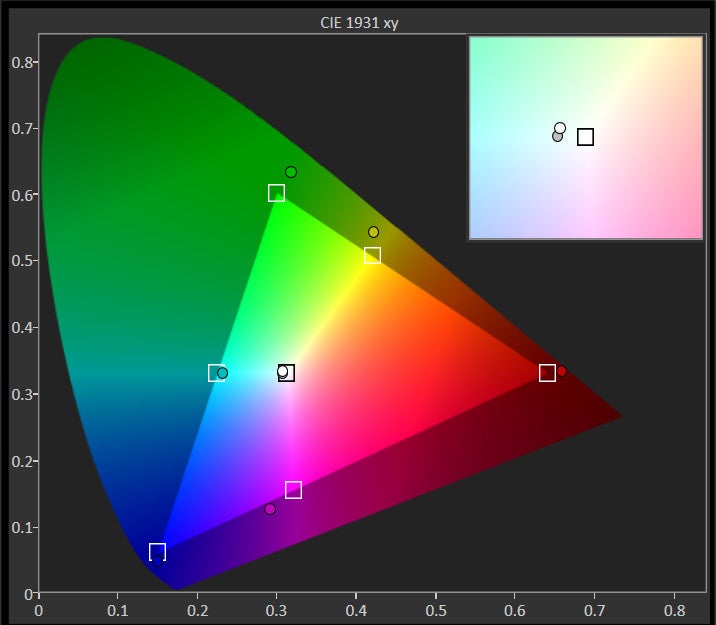Sony Xperia Z1 Compact vs Sony Xperia Z1

Introduction
The Sony Xperia Z1 and the Sony Xperia Z1 Compact are two phones that have quite a lot in common. They share the same OmniBalance design that's typical for Sony's smartphones, they're both waterproof, and they both pack the hardware specs we've come to expect out of a high-end Android device. Size, however, is the key factor that sets them apart. The Xperia Z1 comes with a 5-inch screen and is obviously the chunkier one of the two, while the Z1 Compact is physically smaller as it is equipped with a 4.3-inch display. But is there anything else that makes these two phones different from one another, and ultimately, which one should you pick? Well, let's dive further into it and check them out in detail.
Design
The Sony Xperia Z1 Compact is a phone that lives up to its name. All there is to love about its bigger brother, the Xperia Z1, it has adopted without compromise. In other words, the Xperia Z1 Compact looks and feels just like a smaller Xperia Z1, with the only difference between them being the arrangement of the ports on the sides. And that's a great thing. We've already pointed out numerous times how likable of a smartphone the Sony Xperia Z1 is, and the Xperia Z1 Compact feels almost as premium in the hand with its sleek body, built of glass, plastic and metal. As a matter of fact, we aren't sure if it is just us, or Sony's OmniBalance design does look even more appealing in a 4.3-inch size factor. Long story short, both smartphones are worthy of admiration.
Bonus points go for the Z1 Compact for being available in a broader range of colors. There's a conservative black option, of course, but for those who want to stand out, the phone comes in white, yellow, and pink as well. The Sony Xperia Z1 comes in black, white, and purple. A flaw common for both handsets, unfortunately, is that fingerprints stick easily to their glass surfaces. These appear to be easiest to spot on a black model and least annoying on a white one.
Clearly, size is the key differentiating factor between these two smartphones. The Sony Xperia Z1 Compact is very suitable for single-handed operation and we love how it fits comfortably in pockets of all sizes. As for the Sony Xperia Z1, it is thinner, but much heavier and harder to handle because of its dimensions.
Both the Sony Xperia Z1 and Z1 Compact are designed to withstand dust and water damage, as indicated by their IP58 rating. That explains why all ports, with the exception of the 3.5 millimeter headphone jack on the top, are sealed by removable flaps. Thankfully, these don't stand out much and blend well with the phones' shape. That docking port on their side, however, is quite distracting, in our opinion.
On the right sides of the two phones are located their identically designed physical buttons. On both devices we see a volume rocker, a power key, and a 2-stage camera shutter. The power key is easy to reach and having a camera shutter is a nice perk that few other phones have to offer, but the volume rocker could have been a bit larger and more clicky.
Display
The Sony Xperia Z1 Compact and the Xperia Z1 are strikingly similar on many levels, but their screens set them widely apart. And with more than just the obvious size difference, for that matter. On the larger Xperia Z1 we have a 5-inch Triluminos display, which is based on TFT LCD technology. Resolution is 1080 by 1920 pixels (441ppi), as it is now the norm for premium Android phones. With the Sony Xperia Z1 Compact we get a smaller, 4.3-inch screen with a resolution of “only” 720 by 1280 pixels, resulting in a pixel density of 342 ppi. What's more worthy of being pointed out, however, is that the screen is made using IPS technology – a first for Sony.
So at the end of the day, which phone has the better screen? Well, that's tough to say since both have their advantages and drawbacks. Looking at figures alone, the Sony Xperia Z1 has the upper hand, offering more pixels per inch of real estate than its smaller sibling. Images and graphics are clearer and more detailed as a result of that, and we won't be wrong if we say that the Xperia Z1 is the phone more suitable for browsing the web, playing games, watching video, and other kinds of multimedia-related activities. On the other hand, we must admit that the screen on the Sony Xperia Z1 Compact is more pleasant to look at thanks to its livelier colors and wider viewing angles. Not that we have anything against Sony's Triluminos tech, but the colors shown on the Z1 Compact's IPS screen are simply more accurate and more pleasing to the eye. To sum it all up, people who spend a lot of time actively using their smartphone would appreciate the extra space offered by the Xperia Z1's screen, but those who feel like going for the eye candy would be more satisfied with the Z1 Compact.
Outdoor visibility is excellent with both smartphones as their displays are perfectly usable even under broad daylight. That's mostly due to their high brightness output of around 500 nits. It also helps that their displays resist fingerprints well, unlike their glass backs, as we mentioned earlier.
A cool extra feature that you get with the Sony Xperia Z1 Compact is Glove mode, which you can activate when needed. It boosts the touchscreen's sensitivity enough for it to detect input through light fabrics, which allows one to, let's say, launch apps or pick up calls without taking their gloves off. In contrast, the Sony Xperia Z1 doesn't offer an extra-sensitive touchscreen.
Interface and functionality
Well, what do you know: the UIs on the Sony Xperia Z1 and Xperia Z1 Compact are nearly identical both in terms of appearance and functionality. The two phones share the same lock screens, the same set of pre-loaded widgets, the same array of options for personalization, a similar drag-down notification panel with toggle buttons on top,... you get the idea. Software-wise, one of the few differences between these devices is that the Sony Xperia Z1 Compact ships with Android 4.3 out of the box, while the Xperia Z1 is still on Android 4.2.2. Both should get Android 4.4 KitKat eventually.
When compared to other custom interfaces for Android, Sony's solution ranks among the more polished and better-designed ones, and although it isn't exactly perfect, it doesn't disappoint either. We are happy to see that Sony has made the extra effort to customize every app and every menu, thus creating a unified, consistent look for its custom UI. The user experience is spiced up with subtle animations and transparency effects – it is lively, but far from distracting. In terms of functionality, we appreciate having the mini apps at our disposal for those times when we need to make a calculation or take a note without switching to a dedicated app for that.
After using your Xperia Z1 or Z1 Compact for a short while you will surely come across the toolbar placed in the app drawer. And chances are you'll discover it by accident, just like we did. It is toggled with a swipe to the right and it lets you filter or search through your installed apps.
The on-screen keyboard loaded on the two Xperias is very flexible when it comes to customization, which means that it can have all its bells and whistles activated, or it can be left in its bare-bone state, depending on the user's preferences. With its multiple layouts and skins, this is one of the most customizable Android keyboards that we've come across. And it is easy to use, too. Because of its width, the Sony Xperia Z1 Compact is suitable for single-handed typing, while the Xperia Z1 is easier to type on using two thumbs.
Processor and memory
The very same chip powers both the Sony Xperia Z1 and Xperia Z1 Compact. That's Qualcomm's Snapdragon 800 beast of an SoC, with its four Krait 400 CPU cores that can sprint at up to 2.2GHz. Needless to say, performance is stellar regardless of which phone you pick. Tasks are executed swiftly and lag-free 99% of the time thanks to the phones' potent hardware configuration. Interestingly, the Z1 Compact outruns its bigger brother when it comes to running graphically-intensive applications, such as 3D video games. Even though both phones have the Adreno 330 GPU ticking under their hoods, the Z1 Compact can reach slightly higher framerates due to the lower resolution of its display. This advantage is negligible, however, as even the heaviest games in the Google Play store run perfectly fine on the Xperia Z1.
Two gigabytes of RAM are present on both the Sony Xperia Z1 and Xperia Z1 Compact – a sufficient amount ensuring that multitasking issues are non-existent. Sure, we've already had the chance to handle phones and tablets with 3GB of RAM on them, but to tell you the truth, the Xperias feel super snappy even with a gig less.
16GB of file storage is available on both the Xperia Z1 and Z1 Compact. Of course, some of that is occupied by the operating system, so the actual storage space they have to offer is around 12GB. That's not a terribly low amount by any means, but heavy users might want to provide themselves with extra space with the help of a microSD card.
Internet and connectivity
Moving further down the list of things the Sony Xperia Z1 and Xperia Z1 Compact have in common, Chrome is pre-loaded on both of them, serving the purpose of a default internet browser. And it gets its job done pretty well. Pages are loaded fast, scrolling is smooth, and one can enjoy the app's many perks, such as its built-in data compression and the option to have tabs and bookmarks synchronized across devices. Thanks to the higher resolution and larger screen size, however, web browsing is a more pleasant experience on the 5-inch Xperia Z1.
LTE is supported by both the Sony Xperia Z1 and Z1 Compact – if they are band-compatible with your carrier of choice, than you'll be enjoying speedy web access while on the go. If no LTE is available, then you still have HSPA+ at 42Mbps at your disposal. It goes without saying that the two handsets support Wi-Fi, Bluetooth, GPS, and NFC.
Camera
One of the many perks you get with the Sony Xperia Z1 is a 20.7MP camera. The snapper is remarkable not only for its sheer pixel count, but also for the 1/2.3" footprint of its sensor – a size that ranks it among the larger sensors found on a smartphone today. On the Sony Xperia Z1 Compact we find the very same camera module, with the same f/2.0 aperture for improved low-light performance and the same 27mm optics for a wider field of view. Both phones come with a 2-stage camera shutter key that can be used for launching the camera from the lock screen and for taking photos, of course.
Call it a shocker if you will, but the camera software on the two phones is identical, too. By default, the cameras on the Z1 and Z1 Compact are set to shoot 8MP photos in Superior Auto mode, which intelligently adjusts the scene settings depending on what is being photographed. The mode is as simple to use as it gets for there's no need to tweak any settings whatsoever. Those who need to have more control over the image are free to switch to Manual mode. It gives access to some image settings and allows one to take photos in full 20.7MP resolution.
Photos taken with the Sony Xperia Z1 and Xperia Z1 Compact look great, we're happy to report. Even if you stick to using just the default Auto mode, you'll be getting high-quality, detail-rich 8MP images with accurate, natural color tonality. These shots can be easily shared online or turned into an average-sized print. Surprisingly, we noticed that the photos from the Xperia Z1 were sharper and more detailed than those from the Z1 Compact, but we'd call this difference in quality negligible.
Taking clear and detailed photos indoors is also a piece of cake for both Xperias. The result is lots of detail in the shots, a tolerable amount of digital noise, and very natural color balance, with the last being especially true for the Z1's images. But to our disappointment, the Xperia Z1 and Z1 Compact struggle with shooting photos at night – think images of brightly lit up building façades – as they often mess up the color accuracy. Also, some night scenes turn out underexposed.
Both phones can shoot 1080p video at 30 frames per second. The lack of support for shooting video at 60fps or at 4K resolution is underwhelming, however. Still, their videos look pretty good overall – not the best we've ever seen, but smooth and detailed enough to be enjoyed. Sound in their videos is loud and clear.
Multimedia
Yup, you guessed it. The Sony Xperia Z1 and Xperia Z1 Compact offer the very same music player. Called Walkman, it is one good-looking and extremely functional piece of software with tons of perks like the ClearAudio+ and xLOUD sound enhancing features. Of course, you get widgets for your home screen, lock screen controls, and an equalizer that you can tune to your liking. We like how the player can automatically find and download any missing album art and information about our songs.
The Sony Xperia Z1 is a great phone to watch video on. The display looks good and is big enough so you can even watch full-length movies on it, if need be. It supports all the popular formats, and even if you manage to find a video that is not playable with the stock player, you should be able to fix this by downloading a capable third-party player from the Play Store. With its smaller screen, the Sony Xperia Z1 Compact isn't an ideal phone to watch video on. Sure, the display looks very good in all of its IPS glory, and we wouldn't mind watching a short video every now and then on it, but we don't find it suitable for watching a full-length movie.
Call Quality
If we had to pick a favorite among these two phones, we'd go with the Sony Xperia Z1 Compact. It has a loud, clear-sounding earpiece and a high-quality microphone ensuring that our voice sounds natural on the other side of the line. But don't get us wrong as the Xperia Z1 isn't bad at all when it comes to making plain old phone calls. Quite the opposite – it is definitely fit for the task, but it isn't as great-sounding as the Z1 Compact.
Battery
Due to the smaller size of the handset, Sony has been unable to fit a very big battery inside the Z1 Compact. In contrast to the chubby, 3000 mAh unit in the Z1, the Z1 Compact only has a 2300 mAh battery. But with its smaller screen and lower resolution, the latter should have lesser power requirements in comparison to its larger sibling. According to official data provided by the manufacturer, the Sony Xperia Z1 Compact should last for about 18 hours of continuous talk-time on 3G, or the impressive 25 days in 3G stand-by (22.9 days on 4G). The Xperia Z1 can last through “only” 15 hours of 3G talk time, but delivers an even more impressive 35 days of stand-by on a 3G network, or 31.7 days on 4G. Of course, the actual time between charges will vary from one user to another, depending on their usage habits.
Conclusion
As we expected, the Sony Xperia Z1 and the Z1 Compact are truly identical on many levels – from design and internal hardware specs to software and camera performance. Metaphorically speaking, they are like two different serving sizes of the very same ice cream flavor. That is why a potential buyer who is torn between them should be most influenced by the size factor that sets these two phones apart. We find the Xperia Z1 Compact much more suitable for those who value ease of use above all; those who would appreciate owning a top-notch phone that they can easily operate with one hand and fit in any pocket. On the other hand, people who often find themselves watching videos or photos, browsing the web, or playing games on their smartphone should be more satisfied with the Xperia Z1 since its bigger, higher-resolution screen is a huge asset when it comes to multimedia consumption. Overall, we find both phones equally appealing, which is why whichever you pick, we doubt you'd end up feeling disappointed.




























Things that are NOT allowed: